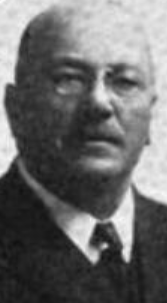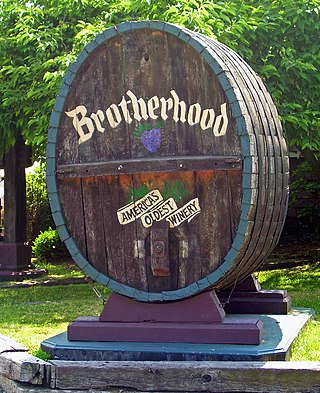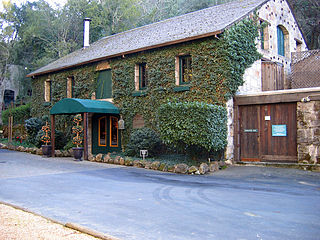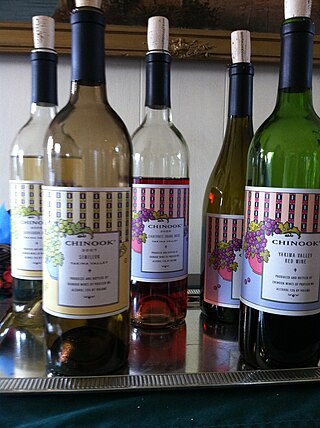
The Santa Cruz Mountains are a mountain range in central and Northern California, United States, constituting a part of the Pacific Coast Ranges. They form a ridge down the San Francisco Peninsula, south of San Francisco. They separate the Pacific Ocean from the San Francisco Bay and the Santa Clara Valley, and continue south to the Central Coast, bordering Monterey Bay and ending at the Salinas Valley. The range passes through the counties of San Mateo, Santa Clara, and Santa Cruz, with the Pajaro River forming the southern boundary.

Almaden Valley, commonly known simply as Almaden, is a valley and neighborhood of San Jose, California, located in South San Jose. It is nestled between the Santa Cruz Mountains to the west and the Santa Teresa Hills to the east, bordering the town of Los Gatos and West San Jose neighborhood.

Paul Masson was an early pioneer of California viticulture known for his brand of Californian sparkling wine.
GALLO is a winery and distributor headquartered in Modesto, California. It was founded in 1933 by Ernest Gallo and Julio Gallo of the Gallo family, and is the largest exporter of California wines. It is the largest wine producer in the world, producing over 3% of the world's entire annual supply of 35 billion bottles with an annual revenue of $5.3 billion it is also the largest family-owned winery in the United States. Gallo provides about 3,500 jobs to Modesto residents and 2,500 jobs in other parts of the state, country, and world.

Kathryn Kennedy was a California wine grower, establishing her vineyard during the growth phase in the California wine history known as "The Wine Boom of the early 1970s". While not the first woman winemaker, Kennedy was one of the first owners of a brand to bear a woman's name in California, and one who came to the scene independent of the young women graduates of the University of California-Davis.

Savannah–Chanelle Vineyards is a 53-acre (210,000 m2) vineyard located in the eastern foothills of the Santa Cruz mountains above Saratoga, California and the Silicon Valley. The vineyard was renamed Savannah-Chanel Vineyards in 1996 when the Congress Springs Vineyards were purchased by the Michael Ballard family, naming the vineyard after the family's two daughters.

California wine has a long and continuing history, and in the late twentieth century became recognized as producing some of the world's finest wine. While wine is made in all fifty U.S. states, up to 90% of American wine is produced in the state. California would be the fourth largest producer of wine in the world if it were an independent nation.
Chateau Ste. Michelle is a winery in Woodinville, Washington, United States, 20 miles (32 km) east of Seattle. It is the state's oldest winery and produces Chardonnay, Cabernet, Merlot, and Riesling, and has winemaking partnerships with two vintners: Col Solare is an alliance with Tuscany's Piero Antinori and Eroica Riesling is a partnership with the Mosel's Ernst Loosen. Chateau Ste. Michelle was selected as Wine Enthusiast magazine's 2004 American Winery of the Year. It was owned by Altria, and then sold to the private equity firm Sycamore Partners in 2021.

Inglenook is a winery that produces estate bottled wines in Rutherford, California, in the Napa Valley.

Cresta Blanca Winery was one of the original Livermore Valley wineries. It was founded by Charles Wetmore in 1882 with cuttings of Sauvignon blanc from Chateau d'Yquem and other top Bordeaux properties. Its first vintage, a dry white wine in 1884 won Grand Prize at the 1889 Paris Exposition, becoming the first California wine to win a competition in France. The victory also assured the future of the California wine industry, which had fallen upon hard times.

Santa Clara Valley is an American Viticultural Area (AVA) located mostly in Santa Clara County, California. The area served an important role in the early history of California wine and was home to the pioneer winemakers Paul Masson and Charles Lefranc. It was established on April 27, 1989 by the Bureau of Alcohol, Tobacco and Firearms (ATF), Treasury after evaluating the petition proposing a viticultural area in Santa Clara, San Benito, San Mateo and Alameda Counties that extends from lower San Francisco Bay with the cities of San Jose, Santa Clara, Menlo Park, Mountain View and Fremont toward the southern boundary near Gilroy and Morgan Hill, outlining the viticultural area named "Santa Clara Valley." It includes the historic winegrowing areas of Santa Clara County not already within the [Santa Cruz Mountains viticultural area, plus the area near Mission San José in Alameda County and a small part of San Benito County. Santa Clara Valley encompasses the established viticultural areas, Pacheco Pass and San Ysidro District.

The history of American wine began when the first Europeans explored parts of North America, which they called Vinland because of the profusion of grape vines found there. However, European settlers, namely the Spanish, would later discover that the wine made from the various native grapes, had flavors which were unfamiliar and which they did not like. This led to repeated efforts to grow familiar Vitis vinifera varieties. The first vines of Vitis vinifera origin came up through New Spain (Mexico) and were planted in Senecu in 1629, which is near the present day town of San Antonio, New Mexico.

The Spring Mountain District AVA is an American Viticultural Area located in the Napa Valley AVA in California. Spring Mountain District AVA was officially established as an American Viticulture Area in 1993. Encompassed within its bounds are about 8,600 acres (3,480 ha), of which about 1,000 acres (400 ha) are planted to vineyards. Given the small crop yields on hillsides, the region represents less than 2% of Napa Valley wine. Currently the region has just over 30 winegrowers.

Almaden Vineyards, historically written as Almadén Vineyards, is a Californian winery. Founded in 1852, it is the oldest commercial winery in California. Originally located and established in Almaden Valley, San Jose, the winery has since moved to the San Joaquin Valley, primarily based in Escalon and Madera.

California wine production has a rich viticulture history since 1680 when Spanish Jesuit missionaries planted Vitis vinifera vines native to the Mediterranean region in their established missions to produce wine for religious services. In the 1770s, Spanish missionaries continued the practice under the direction of the Father Junípero Serra who planted California's first vineyard at Mission San Juan Capistrano.

Buena Vista Winery is a winery located in Sonoma, California, United States. It is the second oldest winery in California after the D'Agostini Winery, which was founded a year prior in 1856. It was founded by Agoston Haraszthy in 1857. The winery is located on its original grounds, just east of Sonoma, California.
Rancho San Juan Bautista was a 8,880-acre (35.9 km2) Mexican land grant in present-day Santa Clara County, California given in 1844 by Governor Manuel Micheltorena to José Agustín Narvaez. The grant extended along the Guadalupe River from Los Gatos to San Jose. Within its boundaries were much of today’s Willow Glen, Hillsdale, Robertsville and the Lone Hill area.

Chinook is a Washington winery located in the Yakima Valley AVA. Founded in 1983 by the wife and husband team of Kay Simon and Clay Mackey, Chinook was one of the pioneering wineries that established Prosser, Washington as a major wine-producing region in Washington state. Kay Simon, who began her career after graduating in 1976 from University of California-Davis in California's San Joaquin Valley and at Chateau Ste. Michelle, was one of the first female winemaker in Washington State. Chinook wines are widely regarded for their quality and help spread recognition for Washington wines. They are considered by wine experts such as Paul Gregutt to be "the classic expression of Yakima Valley fruit". Chinook's work with Cabernet franc, in particular, has garnered the statewide acclaim with the dry Cabernet franc rosé often described in wine reviews as a "Washington Chinon".

Kenwood Vineyards is a winery in Kenwood, California, located on Highway 12 in the Sonoma Valley wine country. It is currently owned by Pernod Ricard Winemakers.
















